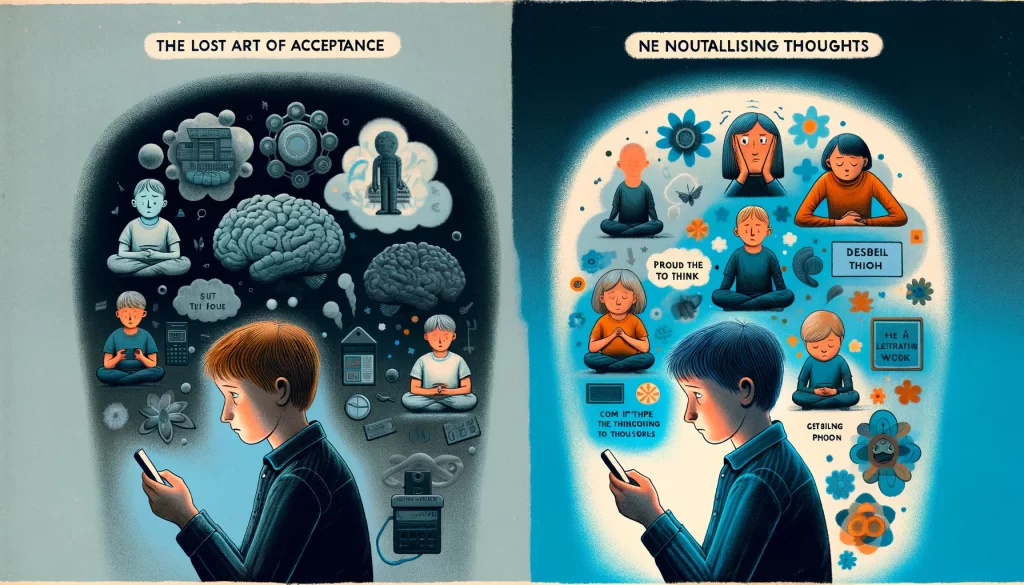Unravelling the Myth of a Stress-Free Past: A Personal Exploration

“Remember the good old days?” That’s a question we hear a lot, right? It seems like everyone thinks the past was a time when people were always happy and never stressed. Well, in this blog, I’m going to challenge that idea. I’ll argue that maybe our ancestors weren’t always living in bliss. Could it be that we’re just painting an overly rosy picture of the past? Maybe life back then was just as full of ups and downs as it is today. Let’s dive in and explore this together!
Understanding Stress in Historical Context
It’s essential to recognise that the concept of ‘stress’, as we understand it today, might not have been identified similarly by previous generations. This isn’t to say they didn’t experience stress, but their understanding and expression likely differed from ours.
Sure thing! Here’s a more straightforward version while keeping all your original points:

Our Ancestors Weren’t Stress-Free Wizards, You Know!
Alright, let’s set something straight. Some people think that our great-grandparents and their parents lived in a world where everyone was always happy, never stressed, and always got along. But guess what? They were just like us! They felt jealous sometimes, like when someone else had a more excellent horse or a more extensive farm. And they wanted to live comfortably and have nice things, just like we do. Being a human means you feel all these things, and it’s normal. It’s not like everyone in the past was magically free from wanting more or feeling a little green with envy.
Back then, people didn’t talk about feeling stressed or worried. It wasn’t because they didn’t feel it; they probably did. But maybe they didn’t know how to talk about it, or perhaps everyone thought you shouldn’t talk about your problems. Instead, they just accepted things as they were. It wasn’t because they were all super bright or knew all the answers to life’s big questions. It was more like they thought, “Well, this is just how things are, so I guess I’ll deal with it.” It wasn’t about being super deep and thoughtful; it was just how people thought back then.

The Lost Art of Neutralising Thoughts
Our ancestors possessed a tool for managing life’s challenges, which we seem to be losing – the ability to neutralise thoughts. This process involves more than just acceptance; it’s about actively transforming how we perceive and react to situations.
Acceptance, where we agree to something, often doesn’t last very long. For example, think about kids and mobile phones. If kids decide not to use phones because their parents say so, they might wait for a chance to use them secretly. They’re accepting the rule, but they might not believe in it.
Now, let’s talk about neutralising thoughts. This is when you think about something and come up with a logical or silly reason. It’s like saying, “Using a phone too much might make it harder for me to focus on my homework.” Here, the kid isn’t just agreeing because someone told them to; they’re thinking it through and finding a reason that makes sense.
The big difference? When you neutralise a thought with your reasons, it’s more likely to have a lasting impact. You’re not just accepting something because you have to; you’re getting it because you see why it makes sense. That’s why neutralising is a better way to change our thoughts and actions than just accepting things without questioning.

Why Asking “Why Me?” Can Make Things Tougher
In today’s world, many people often wonder, “Why me?” when something goes wrong. When they don’t get the toy they wanted or miss the bus, they think it’s always bad luck for them. Guess what? This way of thinking makes them feel more stressed. It’s like carrying a heavy backpack that gets heavier whenever they think, “Why me?”
But there’s another group of people who think differently. When something wrong happens, instead of just feeling sorry for themselves, they try to find a good side to it. Maybe they missed the bus, but then they think, “Hey, now I get to enjoy a nice walk and some fresh air!” Or if they don’t get the toy they wanted, they might think, “This is a chance to play with all the other cool toys I have!”
These people are doing something called ‘neutralising’ their thoughts. It’s like they have a magic wand to turn their sad ideas into happier ones. They look for reasons to be okay with what’s happening or find something good in it. And you know what? These people usually feel calmer and happier. It’s like they have a lighter backpack because they keep removing the heavy stuff and replacing it with feathers!
Have you ever noticed people asking, “Why? Why me?” have a more challenging time relaxing? It’s like they can’t turn off their worry button. For example, let’s say someone does something not so nice to someone else. One way to handle it is to think, “Well, they did that to me first, so it’s okay I did it back. No big deal.” That’s them trying to make their thoughts less heavy.
But then there are sensitive folks who think a lot. They start feeling sorry if they do something they’re not proud of, even if someone did it to them first. They think, “I shouldn’t have done that. It wasn’t right.” And guess what? That kind of thinking can stress them out.
Here’s another thing: say your friend has more money and always seems to be having fun. You might feel jealous, thinking, “Why can’t I have that? Why are they always so happy, and I’m not?” Sometimes, we think someone is happy just because of what we see, but we don’t know the whole story.
If you want to not feel so down about it, there are two ways to change your thinking. The negative way is to think, “Ah, they’re probably not getting their money the right way,” or “They’re just wasting their money.” That’s one way to make yourself feel a bit better.
But there’s also a positive way. You can think, “They must work hard. Maybe I can learn something from them or how they do it.” This way, instead of feeling bad, you get inspired to do something cool yourself.
I’m not saying one way is better than the other. It’s just two different ways to look at things – one is more hostile, and the other is more about finding something good or helpful.

The Role of Religion in Neutralising Stress
In its unique way, each religion has provided narratives and teachings that help mitigate the stress from constant questioning. Whether it’s the reflective dilemmas found in Hindu epics, the moral education in Christian parables, the spiritual guidance of Islamic texts, or the philosophical insights of Buddhism, these religious doctrines have offered ways to alleviate the restless human mind.
These teachings often serve as tools to neutralise the anxiety and stress that arise from constant existential questioning. By offering perspectives that transcend the immediate concerns of daily life, they provide a sense of larger purpose or understanding, easing the mental strain of life’s many uncertainties.
In essence, religions worldwide have not just been about worship or rituals; they have been instrumental in helping individuals find calm in the storm of ‘Why me?’ and ‘What’s the purpose?’ This approach to neutralising stress by providing profound answers and perspectives is a common thread in human history and spirituality.
Let’s take the example of the Bhagavad Gita to understand this better. In this Hindu scripture, Arjuna faces profound moral and existential dilemmas that can lead to a lot of stress. The Gita addresses these by introducing deep concepts like Karma, which help Arjuna see his situation from a new perspective. This isn’t just about giving answers; it’s about transforming the way he thinks, essentially neutralising his stress and confusion.
It’s important to note that I’m not arguing whether religion is good or wrong here. The point is to recognise how these religious teachings have historically helped neutralise stress-inducing thoughts. They’ve been tools for people to reframe their experiences and find peace amidst life’s turmoil.
This ability of religion to help people cope with existential questions and stress is a testament to its enduring influence and relevance. Whether Arjuna is on the battlefield of Kurukshetra or a modern individual seeking solace, the underlying principle of finding balance through spiritual teachings remains a significant aspect of human history and psychology.
In societies where religious beliefs and practices aren’t a significant part of daily life, people often find alternative ways to deal with stress-causing thoughts. Instead of relying on spiritual teachings to provide comfort and answers, these societies lean more on methods like therapy or medical treatments.
The critical point here is not about which method is better – religion or modern therapy – but about how people find ways to neutralise those thoughts that cause them stress. In cultures where belief is prevalent, teachings and stories might offer a way to understand and cope with life’s challenges. This can be a cost-effective way of managing stress, as it often involves community support and personal reflection without needing external resources.
On the other hand, in places where religion doesn’t play as significant a role, people might turn to psychological therapy or medication. These methods also aim to neutralise stress-causing thoughts through scientific understanding and professional guidance. While these can be effective, they might come with a different kind of ‘cost,’ whether it’s financial, time-based, or the need for ongoing treatment.
The core of this argument is understanding that regardless of the cultural backdrop, every society has developed mechanisms for neutralising stress. It’s about finding a balance and a method that works effectively within that society’s values and resources, aiming to reduce stress with the least ‘cost’ or burden to the individual.

The Double-Edged Sword of Neutralization
However, it’s essential to acknowledge that the process of thought neutralisation has its downsides. If not balanced well, it can lead to escapism, dullness, or a lack of initiative. This can be observed in the history of countries like India, where specific interpretations of religious texts led to passivity and escapism, misinterpreting the essence of teachings like those in the Bhagavad Gita.
Got it! Here’s a casual and humorous conclusion that poses questions for the readers to ponder without any additional context or explanations:
So, What’s the Deal with Stress
I’ve got some zingers for you to noodle over:
Is stress the big bad wolf, or could it be the fairy godmother in disguise sometimes?
What if we tried to high-five stress instead of playing hide-and-seek with it?
Can we genuinely become superstars without a bit of stress as our trainers?
Is living without stress like trying to find a sitcom without a laugh track? That sounds good, but would we miss it?
Should we become our stress whisperers or copy-paste what everyone else is doing?
There are no answers here, just some quirky questions to turn over in your mind. Who knows, maybe while pondering these, you’ll have your own little ‘Aha!’ moment about stress!

